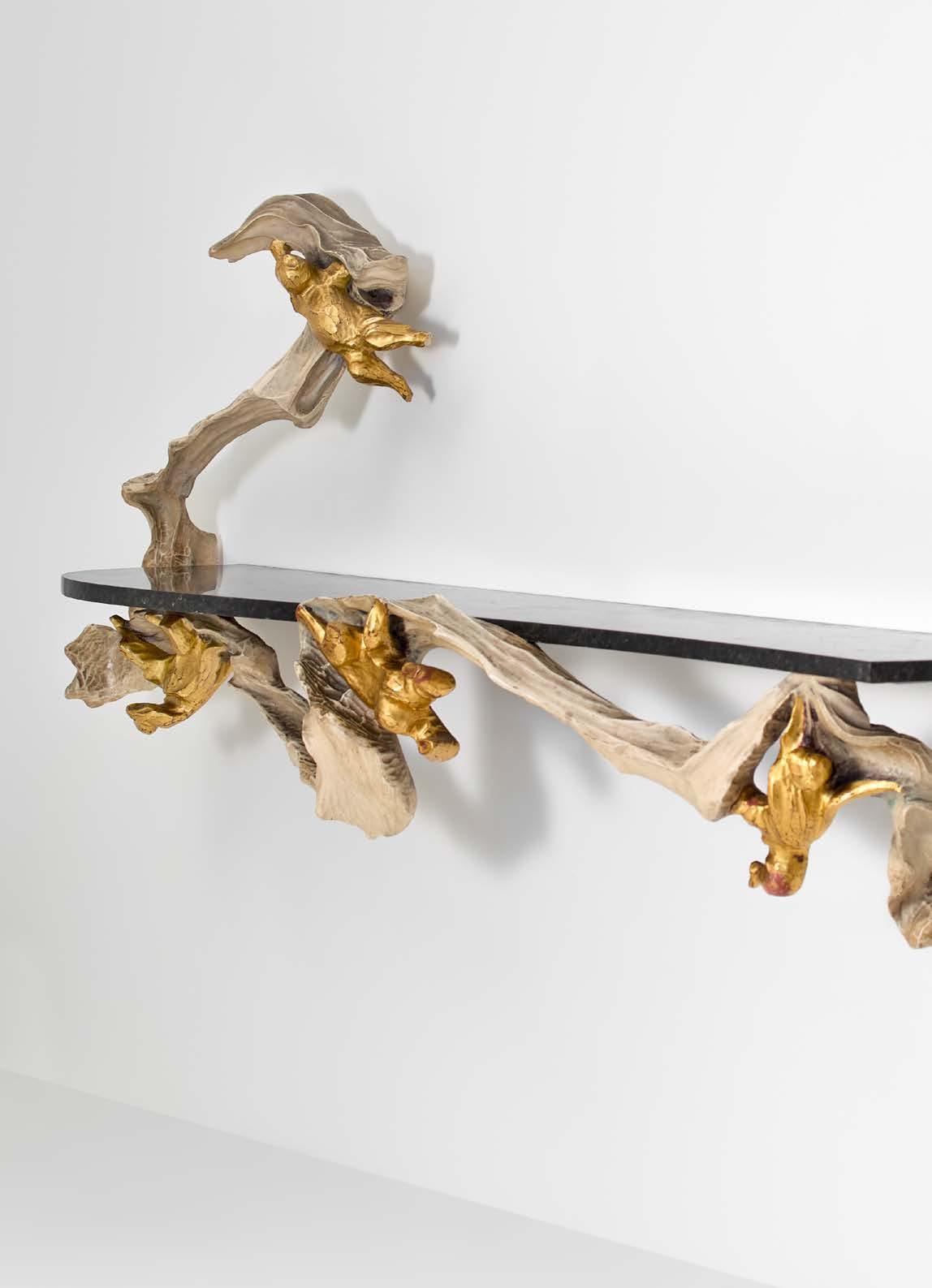

OSVALDO FONTANA BORSANI
LUCIO


This ASTONISHING CONSOLE shelf is one of only three known examples, each differing from the others, yet all conceived by OSVALDO BORSANI and LUCIO FONTANA between the late 1940s and 1951 as part of a coherent POETIC VISION of the domestic interior.
20TH CENTURY
DECORATIVE ARTS & DESIGN
AUCTION: 18–19 December 2025, Milan


Osvaldo Borsani (1911–1985) & Lucio Fontana (1899–1968)
Wall-mounted console shelf decorated with a sculptural group by Lucio Fontana, featuring four gilt putti holding up a draped cloth. Designed for the dining room of Casa G., Milan. Executed by Arredamenti Borsani, Varedo, 1951. Black granite, wood, and painted and gilded plaster. (Minor defects and small restorations.)
Provenance: Casa G., Milan
Literature:
G. Bosoni, Osvaldo Borsani. Architect, Designer, Entrepreneur, Skira, Milan 2018, pp. 308–313. For similar examples: pp. 360–361, p. 566 no. 1950.7234
G. Bosoni, Tecno. The Discreet Elegance of Technology, Skira, Milan 2011, p. 24
G. Gramigna – F. Irace, Osvaldo Borsani, Leonardo – De Luca, Rome 1992, pp. 194–195
Estimate: € 80,000–100,000
This astonishing console shelf is one of only three known examples, each differing from the others, yet all conceived by Osvaldo Borsani and Lucio Fontana between the late 1940s and 1951 as part of a coherent poetic vision of the domestic interior. These are, de facto, unique pieces—custom variations on a single design concept—each created for a specific room in three distinct Milanese residences.
In these works, the furniture’s functional role—specifically that of a wall-mounted shelf—is almost entirely subsumed by an artistic and decorative intent. Inspired by a baroque and rococo imaginary, the furnishings are transfigured into true sculptural pieces.
The setting from which this console originates is described in the catalogue of the recent exhibition that the Triennale di Milano dedicated to Osvaldo Borsani in 2018:
“Of Casa G, we are familiar primarily with the living area, divided into two rooms: the sitting room with a bar area and a piano, opening into a study area, and the dining room, connected to the former through two full-height openings cut into the partition wall.
This sequence of interiors may be regarded as a kind of manifesto of Osvaldo Borsani’s design philosophy: spaces in constant communication, openings and furniture that transform and reveal new perspectives (such as the recessed bar cabinet); the transformation of wall treatments; the invaluable contributions of artists who enhance the representative and personal nature of the project; and the free juxtaposition of furnishings with deliberately varied styles and formal languages—yet which, nonetheless, manage to enter into dialogue and achieve a harmony that transcends fashion and stylistic trends.
Once again, the surreal ceiling light composition by Lucio Fontana—with spiral motifs alternating with informal ceramic geometries concealing the light sources—forms a unique backdrop of strong spatial character. The ceiling appears to come alive and move, becoming a true immersive experience of Spatialist art.
[…]
The same quality and craftsmanship are found in the dining room, where a marble table with inlays by the painter Spilimbergo interacts with a large black console entwined with a sculptural support by Lucio Fontana.”



The same volume also contains information on the other two console shelves designed by Borsani and Fontana for similarly elite Milanese clients:
“Beginning with Casa Gulinello (1947–50), one can observe the nature of this collaboration and see how the artistic contributions— in this case by Lucio Fontana (already involved in the Villa Borsani project)—were seamlessly integrated with the Atelier’s furnishings.
This was not simply a matter of incorporating paintings and sculptures, such as the drawings on the pillar in the living room or the appliqués above the bed, but rather of merging the artistic intervention directly into the furniture itself.
A clear example is the coffee table in the living room, where the vertical element supporting the glass top is wrapped in a fluttering

drapery carved in wood and painted white, pink, and gold. Another is the wall-mounted shelf in the same room, supported by a pair of winged putti holding a veil, also in painted wood.”
“In Casa Melandri (1949–50), this sophisticated elegance—defined by the interplay between refined furnishings and targeted interventions on walls and other architectural elements—becomes the leitmotif underpinning the entire project.
Lucio Fontana’s contributions are again significant here, notably in the design of a sculptural, airy shelf support, much like that of Casa Gulinello, and a sculptural element applied to a service table, similar to the one found in Casa Kramer.”
AUCTION
18–19 December 2025
EXIBITION
11, 12, 13 December 2025
Via Giacomo Medici del Vascello 8, Milan
BIDDING INFORMATION




Register and participate online on the IlPonteLive platform
Participate in the auction by phone and place a bid
Submit a written bid by completing our form

www.ponteonline.com info@ponteonline.com
